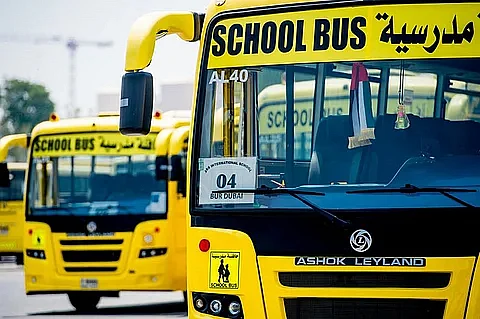Back-to-school: Eight new rules set for safer UAE school buses
School administrations stressed that receiving students is the family’s responsibility

Most public school administrations have issued a detailed circular to parents outlining the regulations governing school transportation. The circular set out eight key rules designed primarily to protect students, ensure their safety, and promote discipline on school buses, thereby supporting a smooth start to the new academic year, which begins tomorrow.
According to the instructions, the first rule requires that students be ready before the bus arrives, as the waiting time outside homes is extremely limited—just a few seconds. Families are therefore expected to prepare their children in advance to avoid delays for other students. The circular emphasized that adhering to this measure ensures that the bus departs on schedule and reflects parents’ awareness of the importance of punctuality.
It further highlighted the importance of having an adult present at the door when the student returns home in the afternoon. Students must not be left unattended, nor should doors be left open in a way that could expose them to risk. School administrations stressed that receiving students is the family’s responsibility, and that this rule is a key safety requirement that cannot be compromised.
Special arrangements
In cases of special circumstances—such as a parent’s request for the child to be dropped off at a relative’s home or if the family is traveling—schools require parents to visit the school and sign a written undertaking specifying the alternative arrangements. This measure, they explained, is organizational in nature, ensuring clarity of responsibility and preventing disruptions to daily transport plans.
Responsibilities of drivers and supervisors
Another rule prohibits students from leaving the bus after boarding, as this could disrupt the driver and supervisors and delay other students along the route. Administrations stressed that once a student boards the bus, they are under the supervisors’ responsibility and may only disembark at school or home according to the established plan.
The instructions also required students to remain calm on buses and wear seat belts at all times, noting that noise or disorder during trips may distract the driver and jeopardize everyone’s safety. Schools considered this rule essential for instilling discipline and teaching students respect for public order when using shared transportation.
Maintaining bus cleanliness
Administrations underscored that bus cleanliness is also a safety element. Eating and drinking on buses are prohibited—not only to maintain a healthy, clean environment but also to protect students from potential accidents such as slipping or choking in a crowded, moving space.
Ban on leaving school on foot
The circular also prohibited students from leaving school on foot or riding in unauthorized vehicles after the school day ends, stressing that buses are the official and approved means of student transportation. Any violation of this rule could expose students to real risks. Schools explained that this measure forms part of a comprehensive strategy to safeguard students both within and beyond the school premises.
Adherence to supervisors’ instructions
The circular further emphasized the importance of students complying with bus supervisors’ instructions, refraining from disorderly conduct or disputes. Supervisors are directly responsible for monitoring students and ensuring their safety, and any violation of the rules will be subject to the Ministry of Education’s approved student behavior code.
Communication with bus drivers
School administrations noted that they had shared the contact numbers of bus drivers and supervisors with parents strictly for emergency use. Supervisors, they clarified, cannot be distracted by phone calls while attending to students unless it is absolutely necessary.
Administrations also urged parents of new students to register their children in the school transport service as soon as possible, to ensure their inclusion on bus lists from the very first day of school. This step, they said, helps ensure a smooth educational process free of logistical obstacles.
In conclusion, schools affirmed that these eight rules represent a shared responsibility between the school and the family. Strict adherence reflects the collective commitment to prioritizing student safety in school transportation. Any breach of these rules will be dealt with in accordance with the Ministry of Education’s behavior code, thereby ensuring a safe and disciplined learning environment and strengthening community partnership in caring for and protecting students.
Sign up for the Daily Briefing
Get the latest news and updates straight to your inbox
Network Links
GN StoreDownload our app
© Al Nisr Publishing LLC 2025. All rights reserved.
